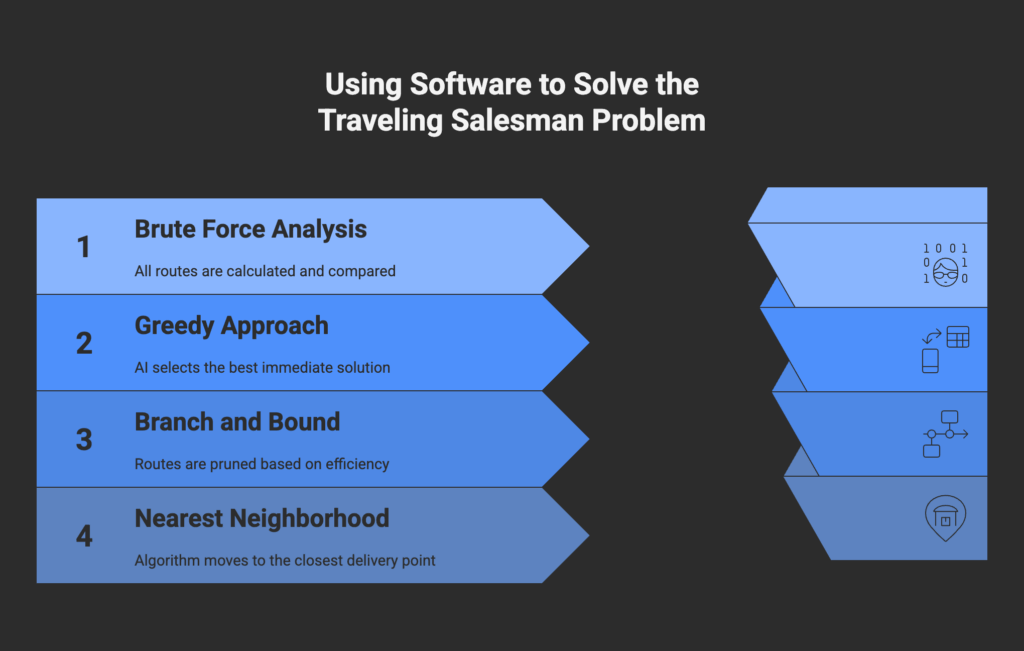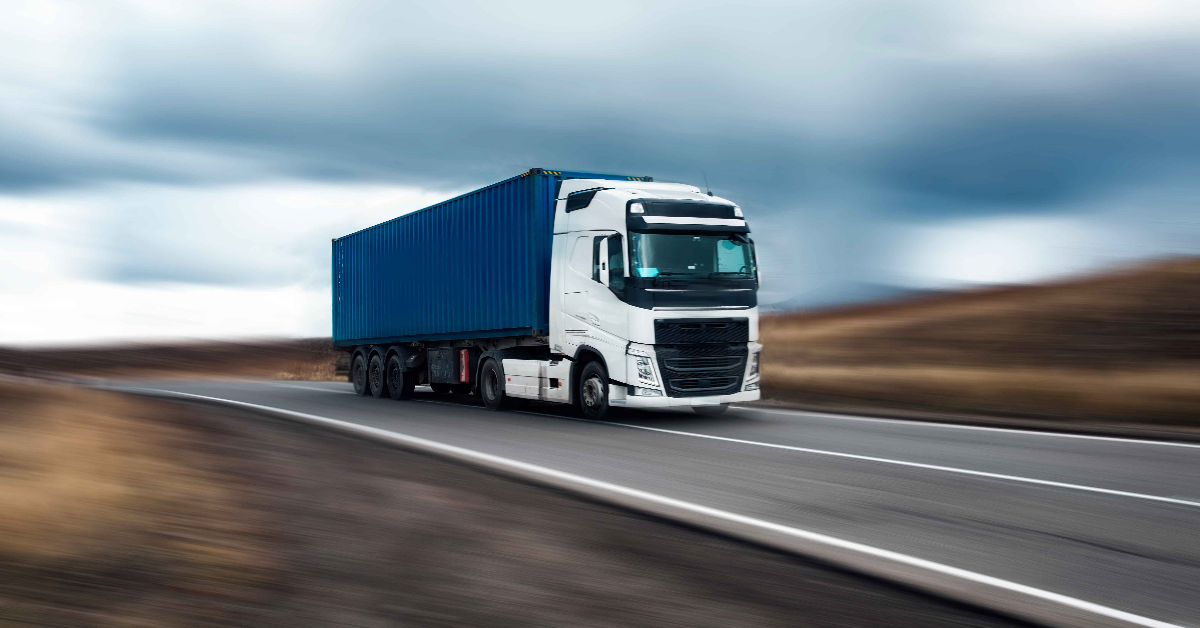Getting packages to customers quickly and efficiently isn’t easy. Many people still think it’s literally just a truck dropping off packages. Period.
Wrong.
Delivery companies constantly deal with unpredictable traffic, tight time windows, and last-minute changes. These can throw an entire day’s schedule off track.
At the heart of this challenge is something called the Traveling Salesman Problem. It’s a logistical puzzle that’s been around for centuries but is more relevant than ever in modern delivery services.
This article breaks down what the Traveling Salesman Problem and solution are. We’ll also look at why it’s a headache in last-mile delivery. Finally, we’ll run through how smart routing technology is helping businesses save time and money.
Let’s dive in.
Key Takeaways
- The Traveling Salesman Problem is still relevant today, even centuries after it was posed, and it remains a core challenge in logistics, especially for last mile delivery, where timing, cost, and customer satisfaction are at stake.
- Modern solutions include today’s advanced routing software that uses AI-powered algorithms like branch and bound to adapt routes in real-time, rather than relying on outdated brute-force methods that are too slow for dynamic conditions.
- Route optimization directly impacts profitability, and businesses that use smart routing and delivery tracking tools can significantly reduce delivery times and costs.
What Is the Traveling Salesman Problem (TSP)?

The traveling salesman problem (TSP) is exactly what it sounds like. About 300 years ago, peddlers of goods began traveling around the United States to sell items.
Because the U.S. at the time had no real monopolies, a single man could convince a household of the value of the goods they were selling.
Salesmen could make small businesses wealthy quickly if they could reach enough homes.
And therein lies the problem.
How quickly can a salesman get to as many houses as possible?
Even in the 17th century, salesmen had to consider how many houses they could get to in a single day, week, month, or year to make decent money.
One hundred years later, mathematicians began working on the issue, and it became a mathematical conundrum.
Mathematicians wanted to help businesses figure out the most efficient routes for their salesmen to visit multiple locations. In short, what is the shortest route that will hit every location and return to the beginning?
The best possible solution to this problem will save time and money and increase revenues.
It is a solution we still hunt for today, and it is particularly confounding in last mile delivery service.
(Last mile delivery service refers to the last leg of delivery for a consumer good. This is when it moves from the local warehouse or transit center to its final destination.)
Why Is TSP a Challenge in Real-World Logistics?
Today, TSP remains a problem in real-world logistics, even with GPS and other mapping tech. Why? Modern businesses don’t just have a single salesman. They have office buildings filled with sales people. And shipping companies have multiple drivers and vehicles (or fleets).
Add to the expansion of resources issues like:
- Sudden weather pattern shifts,
- Traffic conditions,
- Delivery time windows
- Vehicle capacity
- Dynamic changes
Each of these factors can change an optimal route in real time and throw the entire map off. The route will then need to be recalculated, reconfigured, and adhered to by the driver.
For example, a delivery driver may have an optimal route planned on their mobile app. Then, they get into a vehicle accident or blow a tire. Now, commute times are nearing, more vehicles will be on the road, and they’ll likely need a new optimal route configured.
Routing and rerouting in this way is dependent on a traveling salesman algorithm. It can adapt and adjust in real-time for route optimization.
Last mile delivery service software is largely considered good or bad. This is based on the superior performance of the traveling salesman algorithm.
TSP vs. VRP: What’s the Difference?
You may have heard of VRP or the vehicle routing problem, which is similar to TSP but with a modern spin.
When the TSP solution was first conceived of, mathematicians were still largely thinking in terms of a salesman on foot. Sometimes, they even imagined a horse and carriage. Even once salesmen got vehicles, the TSP algorithm only factored for a single vehicle.
Today, however, many delivery services do not have two or three vehicles but a dozen or more — a fleet. So they needed combinatorial optimization for dynamic programming.
The VRP must provide an approximate solution for optimal routes. They must address all modern traveling issues for multiple vehicles. This delivery route solution space is fleet management. You might say that the VRP is a modern-day optimization problem. It’s the expanded version of the classic TSP, which could only have a near optimal solution.
And because businesses and delivery services must contend with both issues at the same time, in real time, you need a software that can also do both.
Last mile delivery service, like at Cigo Tracker, must be able to provide optimal routes. They must do it for an entire fleet and a single delivery vehicle in an ongoing manner throughout the day.
Traveling Salesman Problem Solution: Traditional vs. Modern

The traditional solution to the TSP has long been the brute force solution.
Brute Force
In this model, also known as the naive approach, all possible permutations of a route are calculated and compared. The goal is to determine the shortest option, of course, and this approach can be helpful if your total area is small.
However, the challenges grow almost exponentially as the area and the number of stops increase. You could end up with millions of possibilities that take even a highly intelligent mobile application too long to determine.
More modern solutions for the TSP are “greedy” approaches. Greedy in this instance refers to the ability of AI to see the best possible solution in the immediate without factoring in long-term consequences.
With delivery systems, we often need to be a bit greedy. This is because long-term consequences are constantly changing thanks to outside factors.
The two greedy approaches are brand and bound, and nearest neighborhood.
Branch and Bound
In branch and bound, a single route is chosen from the starting point, and then it begins exploring alternate routes.
Each route that will take longer than the initial route is “pruned” so it will be excluded as a possibility. The driver should ultimately end up with an optimal route that is constantly being examined and explored for better times.
Nearest Neighborhood
With the nearest neighborhood method, the algorithm begins with a single starting point. Then it moves to the next closest delivery point, then the next closest, and so on, on the map.
Yes, this approach might seem like a good idea from a mapping perspective. But it doesn’t consider outside factors and can often take much longer than an optimal route.
Advanced systems today, like Cigo Tracker, will utilize branch and bound in almost all cases. But when taken close up, or in shorter terms, may revert to the nearest neighborhood method. It will always depend on the need, the situation, and the driver.
For Example:
Imagine a local appliance company with one delivery van that needs to make 10 stops across a major city in a single day. Each delivery has a specific time window, and traffic patterns vary significantly throughout the day. Using a brute-force approach to find the shortest route means analyzing over 3.6 million possible combinations. That’s far too many for a human planner or even some older software systems.
Instead, the company uses a modern last-mile delivery solution like Cigo Tracker. The software pulls in:
- Real-time traffic data
- Driver location
- Time windows
- Historical delivery trends
It then applies a branch-and-bound algorithm. This instantly eliminates routes that won’t meet delivery deadlines or that would result in heavy traffic delays.
In under a minute, the system generates an optimized route that minimizes driving time while meeting every customer’s time window. If a delay occurs, like a road closure or a failed delivery attempt, the software re-optimizes the route on the fly and alerts the driver.
As a result, the company:
- Saves hours of drive time
- Cuts fuel costs
- Improves its on-time delivery rate
And they did it while reducing the planning burden on logistics staff. That’s the Traveling Salesman Problem solved… in practice.
How AI & Route Optimization Software Solve TSP for Businesses
A modern tracking system, like Cigo Tracker, will offer myriad features that go well beyond a route optimization algorithm, which is only one tool in a large toolkit.
Typically, modern tracking systems utilize AI to find optimal routes, allow warehouse managers to communicate with drivers, track packages in real-time, and provide analytics and insights.
These are just a few of the features you should expect with a modern tracking application:
Optimized routing
Constant evaluation of the optimal route for individual delivery drivers to save time and money.
Streamline processes from the warehouse to the delivery truck and up through customer interaction.
Fleet route management
Maximize efficiency for your entire fleet, reducing costs and enhancing customer satisfaction.
Last mile management
Cut costs and save time in that last step of the delivery through enhanced route optimization and improved tracking.
Customer engagement
You can notify customers via SMS or email, confirm delivery dates, and track packages in real-time.
Delivery tracking
Barcodes, photographs, and e-signatures can all help improve delivery tracking, especially for last-mile delivery service.
Integrations
Businesses can integrate their tracking applications with their existing CRMs and warehouse management systems for a seamless workflow.
The Future of TSP in Logistics & Delivery Operations
Because businesses now incur much of the cost of shipping in order to stay competitive, it is more important now than ever to ensure tracking systems use the latest AI, machine learning, and predictive analytics to optimize routes, improve tracking, and increase customer satisfaction.
It is imperative businesses find and utilize the best options for automated tracking software, particularly when it comes to final-mile delivery service. Gone are the days of manually mapping out routes and printing out directions.
Delivery services, large and small, must be able to respond quickly to changes that can happen quickly. This means an ability to change routes at the last minute, adapt to multiple delivery windows, offer electronic proof of delivery, and do all of this for multiple vehicles in real time.
Taking advantage of cutting-edge technology that can perform all of these functions can make up for incurred shipping costs and even help increase revenues. The traveling salesman problem solution is the future of shipping.
Why Optimizing Routes Matters for Your Business
With cost savings, high efficiency, and an improved customer experience, delivery companies and businesses managing their own shipping can remain competitive in an increasingly competitive market, even against giants like Amazon and Wal-Mart.
Cigo Tracker is here to help.
Our advanced Route Planning Software technology for Last Mile Tracking ensures your deliveries arrive on time, your costs stay low, and your customers stay happy.
Grab your free trial today and see for yourself.
FAQs
What is the traveling salesman problem, and why is it important for delivery service today?
The TSP is the problem of finding the shortest possible unique route for delivery drivers to travel and deliver packages. It is important today because last-mile delivery service is expensive, and finding the shortest, most efficient route saves money.
How does the TSP impact last-mile delivery?
Last mile delivery is the part of delivery that is the most controllable and can have the most problems because of outside factors. Ensuring the best possible routes will save time and money in spite of these factors.
How does route optimization software benefit fleet management?
Route optimization software will ensure warehouse management systems can track packages and optimize routes for multiple drivers in multiple vehicles, saving time and money for delivery services.
Can the Traveling Salesman Problem ever be fully “solved” for modern logistics?
Not exactly. While there are algorithms that get extremely close to the optimal solution, the complexity of real-world variables makes it nearly impossible to find a single perfect route every time.
These include issues like weather, traffic, last-minute cancellations, and driver availability. Instead, modern software like Cigo Tracker focuses on providing the best possible route at any given moment. We use AI, real-time data, and dynamic optimization to adapt continuously throughout the day.




